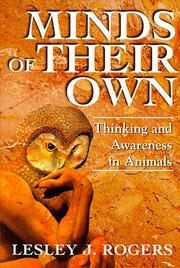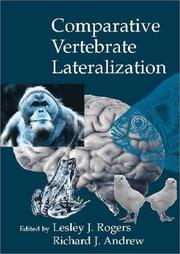| Listing 1 - 10 of 15 | << page >> |
Sort by
|

ISBN: 0231120109 Year: 2001 Publisher: New York Columbia University Press
Abstract | Keywords | Export | Availability | Bookmark
 Loading...
Loading...Choose an application
- Reference Manager
- EndNote
- RefWorks (Direct export to RefWorks)
Brain --- Neuropsychology. --- Sex differences (Psychology). --- Medische psychologie --- Sex differences. --- neuropsychologie. --- Genetics --- Sociology of the family. Sociology of sexuality --- Glandular physiology --- Neuropathology --- Sexology --- Biology --- Philosophy of science --- Philosophy and psychology of culture --- Psychology --- Neuropsychologie. --- Gender --- Homosexuality --- Hormones --- Nature-nurture-debate --- Neurology --- Attitudes --- Sexism --- Sexuality --- Theory --- Book --- Epistemology
Book
ISBN: 0753810239 Year: 2000 Publisher: London Phoenix
Abstract | Keywords | Export | Availability | Bookmark
 Loading...
Loading...Choose an application
- Reference Manager
- EndNote
- RefWorks (Direct export to RefWorks)
How much of sexual diversity is the result of nature versus nurture? Prevailing theories today lean heavily toward nature. Now a leading researcher in neuroscience and animal behavior shows how, in recent history, scientific claims about sex and gender differences have reflected the culture of the time. Although the conviction that genetics can explain everything is now widespread, the author demonstrates the interaction of culture and environment in the formation of behavioral traits and so provides an important corrective to popular notions of reductionism. [publisher's description]

ISBN: 0813390656 Year: 1998 Publisher: Boulder (Colo.) : Westview press,
Abstract | Keywords | Export | Availability | Bookmark
 Loading...
Loading...Choose an application
- Reference Manager
- EndNote
- RefWorks (Direct export to RefWorks)
Book
Year: 2017 Publisher: Basel : MDPI - Multidisciplinary Digital Publishing Institute,
Abstract | Keywords | Export | Availability | Bookmark
 Loading...
Loading...Choose an application
- Reference Manager
- EndNote
- RefWorks (Direct export to RefWorks)
Annotation This edited book brings together research reports on the asymmetry of brain function in various species, including humans, dogs, birds, lizards and bees. As shown in a wide range of species, and, as we now know, not solely in humans, the left and right sides of the brain process information in different ways and control different responses or patterns of behaviour. Since this discovery, many new methods have become available to reveal the processes involved in the development, function and evolution of this important attribute of the brain. Chapters consider the evidence for asymmetry of sensory receptors, left-right differences in information processing and asymmetrical control of behaviour. The latter includes lateralization of bird song and use of the magnetic compass in navigation. Other chapters report studies on handedness, hemispheric asymmetries in emotional processing and perception of symmetry in humans. The importance of the degree, or strength, of asymmetry is discussed and the conclusion is that asymmetry of the brain enhances its efficiency. Other chapters provide evidence that early experience influences the development of asymmetry. All of the contributors have strong backgrounds in research and they discuss up-to-date discoveries on lateralized brain and behaviour.

ISBN: 1864485043 Year: 1997 Publisher: St. Leonards, N.S.W. : Allen & Unwin,
Abstract | Keywords | Export | Availability | Bookmark
 Loading...
Loading...Choose an application
- Reference Manager
- EndNote
- RefWorks (Direct export to RefWorks)
Consciousness in animals. --- Animal behavior. --- Conscience chez les animaux --- Animaux --- Moeurs et comportement
Book
Year: 2017 Publisher: Basel : MDPI - Multidisciplinary Digital Publishing Institute,
Abstract | Keywords | Export | Availability | Bookmark
 Loading...
Loading...Choose an application
- Reference Manager
- EndNote
- RefWorks (Direct export to RefWorks)
Annotation This edited book brings together research reports on the asymmetry of brain function in various species, including humans, dogs, birds, lizards and bees. As shown in a wide range of species, and, as we now know, not solely in humans, the left and right sides of the brain process information in different ways and control different responses or patterns of behaviour. Since this discovery, many new methods have become available to reveal the processes involved in the development, function and evolution of this important attribute of the brain. Chapters consider the evidence for asymmetry of sensory receptors, left-right differences in information processing and asymmetrical control of behaviour. The latter includes lateralization of bird song and use of the magnetic compass in navigation. Other chapters report studies on handedness, hemispheric asymmetries in emotional processing and perception of symmetry in humans. The importance of the degree, or strength, of asymmetry is discussed and the conclusion is that asymmetry of the brain enhances its efficiency. Other chapters provide evidence that early experience influences the development of asymmetry. All of the contributors have strong backgrounds in research and they discuss up-to-date discoveries on lateralized brain and behaviour.
Book
Year: 2017 Publisher: Basel : MDPI - Multidisciplinary Digital Publishing Institute,
Abstract | Keywords | Export | Availability | Bookmark
 Loading...
Loading...Choose an application
- Reference Manager
- EndNote
- RefWorks (Direct export to RefWorks)
Annotation This edited book brings together research reports on the asymmetry of brain function in various species, including humans, dogs, birds, lizards and bees. As shown in a wide range of species, and, as we now know, not solely in humans, the left and right sides of the brain process information in different ways and control different responses or patterns of behaviour. Since this discovery, many new methods have become available to reveal the processes involved in the development, function and evolution of this important attribute of the brain. Chapters consider the evidence for asymmetry of sensory receptors, left-right differences in information processing and asymmetrical control of behaviour. The latter includes lateralization of bird song and use of the magnetic compass in navigation. Other chapters report studies on handedness, hemispheric asymmetries in emotional processing and perception of symmetry in humans. The importance of the degree, or strength, of asymmetry is discussed and the conclusion is that asymmetry of the brain enhances its efficiency. Other chapters provide evidence that early experience influences the development of asymmetry. All of the contributors have strong backgrounds in research and they discuss up-to-date discoveries on lateralized brain and behaviour.

ISBN: 0121245608 Year: 1993 Publisher: San Diego Academic Press
Abstract | Keywords | Export | Availability | Bookmark
 Loading...
Loading...Choose an application
- Reference Manager
- EndNote
- RefWorks (Direct export to RefWorks)
Comparative neurobiology --- Lateralite --- Lateraliteit --- Laterality --- Neurobiologie comparée --- Vergelijkende neurobiologie --- Laterality. --- Comparative neurobiology. --- Latéralité --- Brain --- Neurophysiology --- Physiology, Comparative --- physiology --- Latéralité --- Neurobiologie comparée
Book
ISBN: 1493967258 1493967231 Year: 2017 Publisher: New York, NY : Springer New York : Imprint: Humana,
Abstract | Keywords | Export | Availability | Bookmark
 Loading...
Loading...Choose an application
- Reference Manager
- EndNote
- RefWorks (Direct export to RefWorks)
This volume explores both simple and sophisticated techniques used in the study of different types of lateralization of brain and behavior. Research in this field increases our understanding of various brain functions in humans, other vertebrate species, and invertebrates. The book is divided into five parts: behavioral methods; neurobiological methods; electroencephalographic, imaging, and neuro-stimulation methods; genetic techniques; and development of lateralization. Part I addresses measuring lateralization by scoring behavior induced by inputs to one or the other side of the brain in a range of species. Part II covers neurobiological methods used to reveal lateralization, such as lesion studies, electrophysiology and pharmacology, early gene expression, and new optogenetic methods. Part III looks at imaging techniques, electroencephalographic techniques, and transcranial stimulation to reveal lateralization. Part IV describes techniques used to study the role of genes in the development and establishment of brain asymmetry in humans and other species. Lastly, Part V refers to methods used in the study of development of lateralization through the manipulation of sensory exposure, hormone levels, and in model systems. In Neuromethods series style, chapters include the kind of detail and key advice from the specialists needed to get successful results in your own laboratory. Cutting-edge and thorough, Lateralized Brain Function: Methods in Human and Non-Human Species is a valuable resource for investigating lateralization in a broad range of species and provides excellent advice for both new and veteran researchers. .
Neurosciences. --- Neural sciences --- Neurological sciences --- Neuroscience --- Medical sciences --- Nervous system

ISBN: 0521781612 Year: 2002 Publisher: Cambridge ; New York : Cambridge University Press,
Abstract | Keywords | Export | Availability | Bookmark
 Loading...
Loading...Choose an application
- Reference Manager
- EndNote
- RefWorks (Direct export to RefWorks)
| Listing 1 - 10 of 15 | << page >> |
Sort by
|

 Search
Search Feedback
Feedback About UniCat
About UniCat  Help
Help News
News